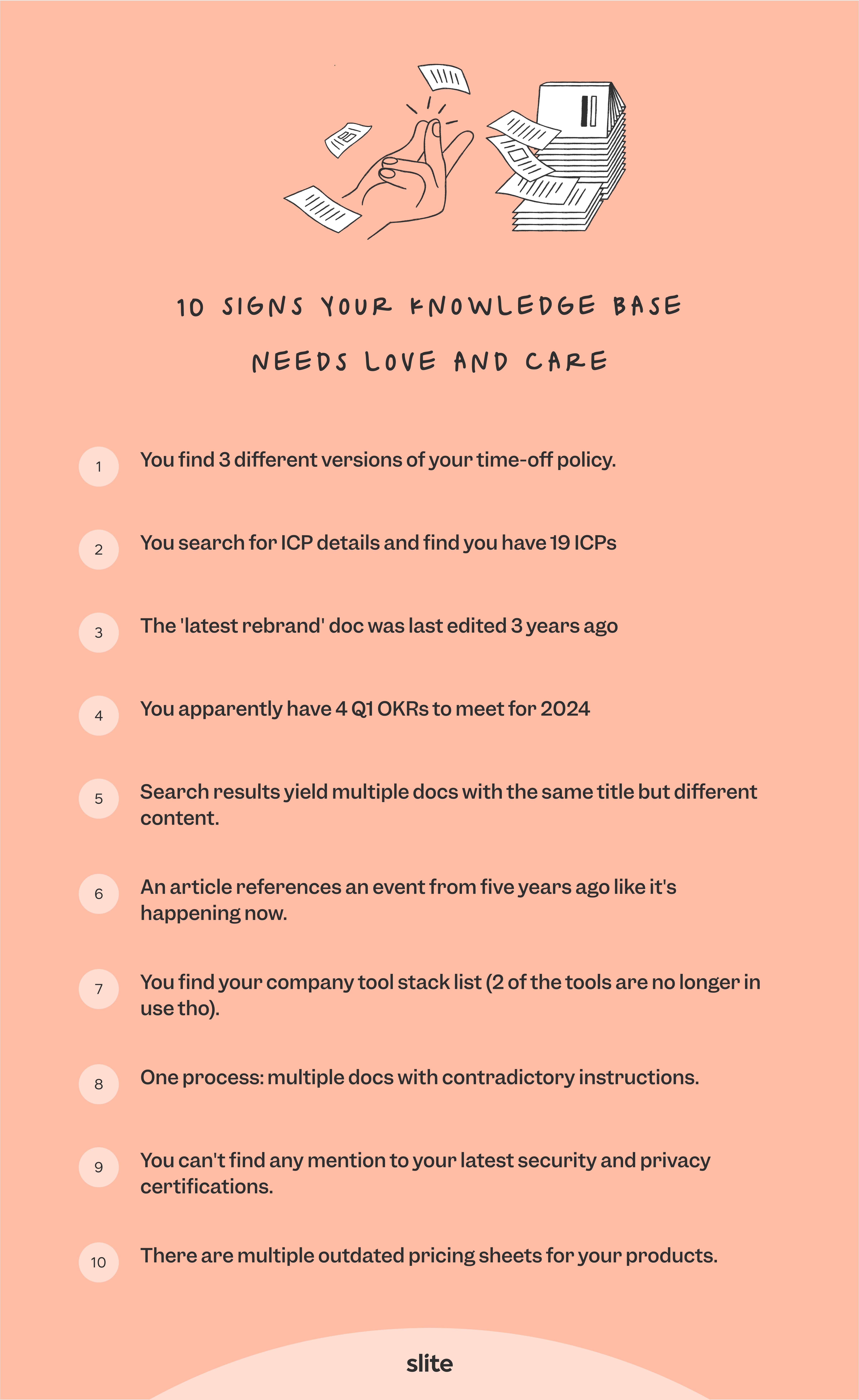Signs your Knowledge Base needs some love

Imagine a special place where all the information your team needs is easy to find and use. It's supposed to be super helpful and organized. But sometimes, it turns into a big mess with old, missing, or repeated stuff. People get lost trying to find what they need and end up asking around in a panic.
But here's the good news: there are people called knowledge managers who help fix this.
They work hard to make sure this information place stays useful and easy for everyone. Managing a lot of information might seem really tough, but there are tools out there like Slite's Knowledge Management Panel that make it easier to spot and fix problems.
We've got a list of 10 signs that show when your knowledge base needs a big makeover.
#1 You find 3 different versions of your time-off policy.
Like an identity crisis, multiple versions of the same documents such as company policies indicate fragmented information rather than one source of truth. Employees find themselves perplexed, asking "Which version is correct?" as they encounter contradictory instructions. This lack of clarity leads to misalignment across teams.
#2 You search for ICP details and find you have 19 ICPs
While some customer segmentation is healthy, an overabundance of similar personas splits your focus. You need a Marie Kondo-style purge to consolidate overlapping profiles into broader categories. Too many looks like you're trying to be everything to everyone instead of delivering targeted value.
#3 The 'latest rebrand' doc is stuck in a time warp.
Old branding, logos, messaging, and designs make your company seem dated, like still sporting 80s acid-washed jeans. Regularly update and note revision dates to keep your image fresh. Don't let how you present yourself to the world languish years in the past.
#4 You apparently have 4 Q1 OKRs to meet for 2024.
Unclear documentation about whether goals and OKRs are for this year or next leaves employees directionless. It's like having your calendar mixed up, unsure what you should be focused on now versus later. Always include target dates so everyone knows what to prioritize in the present.
#5 Search results yield multiple docs with the same title but different content.
Identically titled documents with totally different information are like bots rewriting random content. This provides irrelevant search results and a poor user experience. Institute clear naming conventions and centralize topics into authoritative sources.
#6 An article references a historic event like today's news.
Outdated chronology of company events, product releases, and program histories gives a disjointed, conflicting narrative. It's like piecing together your family tree but all the ages are wrong. Regularly review and update timelines to preserve an accurate sequence.
#7 You find your company tool stack list (2 of the tools are no longer in use tho).
Lists cluttered with old, deprecated tools waste time like trying to navigate unfamiliar territory using outdated maps. Maintain a master list of current tools in active use and archive pages with dead links to prevent confusion.
#8 One process: multiple docs with contradictory instructions.
When separate documents detailing critical processes contain conflicting directions, it leads to costly errors and duplication of efforts. Establish one clearly identified source of truth for each process to eliminate misalignment.
#9 You can't find any mention of your latest security and privacy certifications.
Hard-to-find or buried security and compliance details put your company at risk. It's like classified documents hidden away despite high importance.
#10 There are multiple outdated pricing sheets for your products.
Old, incorrect prices mislead both internal teams and external partners/customers, damaging relationships. It's like selling milk at prices from the 1980s because you never bother to update labels.
Here's a TLDR version you can share with your team:

The verdict: You decide
If your knowledge base exhibits six or more of these troubling symptoms, consider it a dire warning sign that immediate care is needed. Go to archiving, renaming, and updating your docs immediately.
If you need to crunch out the literal math of the productivity loss because of it, think of the number of quick questions you have to answer. You could be doing a lot with that time.
In fact, if anyone in your team needs convincing, just send them a screenshot of this.
And if your score is a 10, don’t get overwhelmed. We’re here. Book a demo with us to discuss exactly how Slite can save you time and money starting as early as next week.
The prescription for mildly sick knowledge bases
There’s a bunch of things you can do to avoid this issue for the longer run:
Hire a Knowledge Manager, please.
Great companies with great documentation have dedicated resources for knowledge management. Read more about it here.
Update your knowledge base tech stack
A bad knowledge base is disconnected from Slack, mail, and other apps where your work actually gets done. A good knowledge base (like Slite, hehe) looks good, is easy to use, has AI features, and has intelligent Knowledge Management features.
For example, our customers complained that updating docs is tough work. So, we built a Knowledge Management Panel right into Slite. It gives individuals an idea exactly which actions to take on their end.

This way, 90% of the boring managing work of identifying outdated docs, or empty docs, gets done automatically for you. Teams who use Slite have been loving this feature.
So, if you’re still stuck on an outdated tool, it’s time to shift to a new one. But we get it if you want to research. There’s a lot of great knowledge bases out there. In fact, when we were reviewing it, we found 22 Knowledge Base software that are the best right now. If you want to check out their pricing, AI capabilities, pros, and cons, you can read our detailed breakdown here.

Written by Elisa Reggiardo
Elisa Reggiardo is part of the Marketing team at Slite where she leads the Partner Marketing motions. She is also a mom, author, and a big fan of delicious wine.


